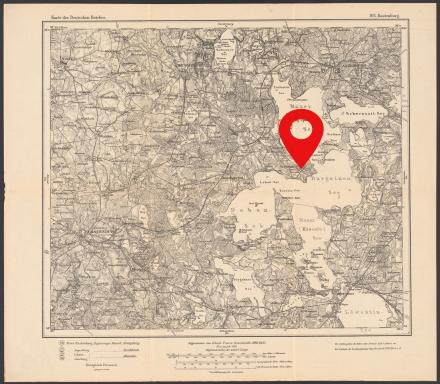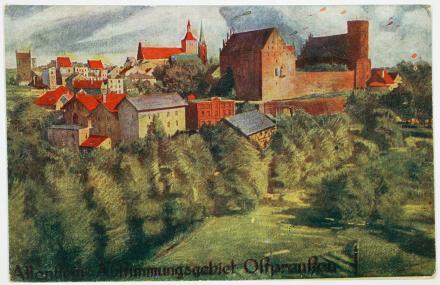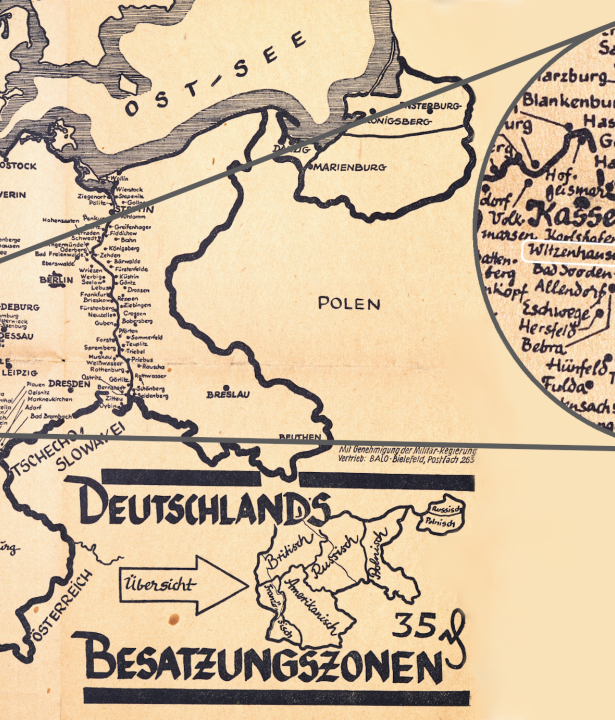For more than 150 years, the Rococo dresser stood on the upper floor of the Steinort castle, in the so-called "Simson room". It bears witness to the lifestyle of an East Prussian noble family. Behind it lies an adventurous journey that began after the failed assassination attempt on Hitler on July 20, 1944, when Heinrich Graf von Lehndorff, the last lord of the castle, was arrested and executed.
The history of a noble family and a national cultural treasure
Text
Some people imagine that the nobility in the faraway region of Masuria must have been rather rural and provincial. "But the dresser tells a different story," says Joachim Mähnert, director of the East Prussian regional Museum. "It is evidence of the Lehndorffs’ international connections. The family commissioned some of the most important artisans in Europe. And they had the money to do so." There were bad times, as we all know, but over the centuries accumulated all sorts of treasures.1
The 18th century dresser was made in the Berlin workshop of Johann Michael Hoppenhaupt the Younger, the famous "ornamental sculptor" who worked for the Prussian court. A piece of furniture in the French rococo style, it is thought to come from the estate of Ernst Ahasverus Heinrich Graf von Lehndorff (1727 - 1811).
Sztynort
deu. Steinort, deu. Groß Steinort
The village of Sztynort is located in the north of the Masurian Lake District on the Jez Peninsula between Jezioro Mamry, Jezioro Dargin and Jezioro Dobskie. Until 1928 the village was called Groß Steinort, then Steinort.
The 18th century dresser was made in the Berlin workshop of Johann Michael Hoppenhaupt the Younger, the famous "ornamental sculptor" who worked for the Prussian court. A piece of furniture in the French rococo style, it is thought to come from the estate of Ernst Ahasverus Heinrich Graf von Lehndorff (1727 - 1811).

The “Simson room”, the Rococo dresser stands in the foreground on the left. Carl E. von Lorck, 1937, Free access - no reuse
The “Simson room”, the Rococo dresser stands in the foreground on the left. Carl E. von Lorck, 1937, Free access - no reuse
Text
As a chamberlain at the Berlin court, he became famous for his diary entries in French, in which he recorded events at court for more than half a century, beginning in 1750.2 In the photo, the dresser can be seen in the foreground on the left, among other Rococo furniture and against the backdrop of a magnificent 17th century Flemish tapestry by Gobelin, one of seven depicting scenes from the story of the biblical hero Samson.
For his castle in Steinort, the chamberlain drew inspiration from everyday scenes in royal Prussian life. He was also influenced by the European Enlightenment, embodied by Frederick the Great. An oil painting that survived the turmoil of time shows the Count and his family: self-confident and dignified, the children appearing independent and natural, in accordance with the new ideals of Jean-Jacques Rousseau.
For his castle in Steinort, the chamberlain drew inspiration from everyday scenes in royal Prussian life. He was also influenced by the European Enlightenment, embodied by Frederick the Great. An oil painting that survived the turmoil of time shows the Count and his family: self-confident and dignified, the children appearing independent and natural, in accordance with the new ideals of Jean-Jacques Rousseau.

Johann Heinrich Wilhelm Tischbein: Portrait of the Lehndorff-Schmettau family, 1779. Ulla Lachauer, Free access - no reuse
Johann Heinrich Wilhelm Tischbein: Portrait of the Lehndorff-Schmettau family, 1779. Ulla Lachauer, Free access - no reuse

Vera von Lehndorff’s second birthday, 1941. Above the bed hangs the Tischbein painting. Ostpreußisches Landesmuseum, Free access - no reuse
Vera von Lehndorff’s second birthday, 1941. Above the bed hangs the Tischbein painting. Ostpreußisches Landesmuseum, Free access - no reuse
Text
The portrait was painted by none other than Johann Heinrich Wilhelm Tischbein, and it is the most valuable legacy from Lehndorff's estate.
A family photograph from 1941 documents that the painting last hung in one of the children's rooms. Today it is in the care of the east Prussian State Museum – like almost everything that remains. According to the inventory, this includes around 200 objects: paintings, graphic prints, furniture, silver items, textiles, porcelain, books. A hodgepodge, including banal things like a champagne bucket, a knife rest, and mismatched individual plates. "You couldn't set a table with them," says Joachim Mähnert.
A family photograph from 1941 documents that the painting last hung in one of the children's rooms. Today it is in the care of the east Prussian State Museum – like almost everything that remains. According to the inventory, this includes around 200 objects: paintings, graphic prints, furniture, silver items, textiles, porcelain, books. A hodgepodge, including banal things like a champagne bucket, a knife rest, and mismatched individual plates. "You couldn't set a table with them," says Joachim Mähnert.

Joachim Mähnert shows items from the museum’s depot. Ulla Lachauer, Free access - no reuse
Joachim Mähnert shows items from the museum’s depot. Ulla Lachauer, Free access - no reuse
Text
Years ago, art historian Kilian Heck researched the history of the inventory, tracing and interpreting lost items. Today, as part of the online edition "Lebenswelten Lehndorff", the historian Gaby Huch is examining files in order to determine the intricate journeys these objects have taken through history.
Intricate pathways
Text
Again and again, the research leads back to the starting point, when Heinrich and Gottliebe von Lehndorff inhabited the castle with their young daughters. Even the task of simply reconstructing what was in the numerous rooms is extremely difficult. There is much dispute and discussion about the extent to which the family was able to secretly move smaller objects and archival materials to safety before or after July 20, 1944.

Steinort Palace in the 1930s. Familienarchiv Lehndorff, Free access - no reuse
Steinort Palace in the 1930s. Familienarchiv Lehndorff, Free access - no reuse
Text
After Heinrich von Lehndorff's execution on September 4, 1944, the family was at the mercy of the Nazis, who confiscated large amounts of their property and forced them to leave their ancestral home. It is conceivable that Foreign Minister von Ribbentrop, who had resided in the west wing of the manor house since 1941 and remained until October 1944, had a hand in this. Everything was taken to Saxony, some items to Kriebstein Castle, and others to the church of the old Wechselburg monastery, which had been designated as a site for storing objects of cultural heritage endangered by the war. According to a note in the files, train carriages containing the Lehndorff's possessions arrived in Saxony on December 24, 1944.
On January 13, 1945, the Red Army entered East Prussia. Soldiers looted the castle; later, the victors transported whole wagonloads of goods to Russia. For a long time, useful things kept disappearing, including household items, stoves, and tiles. The need was great; people arriving in Masuria after being deported from the East had use for these things.
On January 13, 1945, the Red Army entered East Prussia. Soldiers looted the castle; later, the victors transported whole wagonloads of goods to Russia. For a long time, useful things kept disappearing, including household items, stoves, and tiles. The need was great; people arriving in Masuria after being deported from the East had use for these things.

Exhibition in Kętrzyn Castle in 2021. The rescued portrait of Zofia Karolina from 1710 hangs top left. Ulla Lachauer, Free access - no reuse
Exhibition in Kętrzyn Castle in 2021. The rescued portrait of Zofia Karolina from 1710 hangs top left. Ulla Lachauer, Free access - no reuse
Text
In 1947, the Polish museum administration began to secure the last remaining heritage objects and artworks from East Prussian manors. About 20 paintings, some furniture and a number of outdoor sculptures from Lehndorff's property owe their survival to this initiative. The rescue of the valuable sundial, which was brought to by dedicated preservationists, has been recorded in detail.
Most of the remaining items stored in Saxony were handed over to the Soviet Union as reparations. It is estimated that 90% or more of Steinort Palace’s interior is now in Russian depots. A number of museums managed to put a few of the objects aside ahead of their removal in 1946. The famous Tischbein painting, for example, went to the Grassi Museum in Leipzig.
Olsztyn
deu. Allenstein, lat. Holstin, lat. Allenstenium
The city of Olsztyn (population 2022: 168,212) was founded in 1353 as Allensteyn on the Łyna river. Olsztyn is the largest city in Warmia and the capital of the Warmian–Masurian Voivodeship. The city is member of the European Route of Brick Gothic, especially because of its Old Town market sqare and the Castle of Warmian Cathedral Chapter.
The picture shows a city view of Olsztyn /Allenstein on a postcard from before 1945.
Most of the remaining items stored in Saxony were handed over to the Soviet Union as reparations. It is estimated that 90% or more of Steinort Palace’s interior is now in Russian depots. A number of museums managed to put a few of the objects aside ahead of their removal in 1946. The famous Tischbein painting, for example, went to the Grassi Museum in Leipzig.

Kriebstein Castle in Saxony. Gabriele Ottich, Pixabay free, CC BY-NC-SA 4.0
Kriebstein Castle in Saxony. Gabriele Ottich, Pixabay free, CC BY-NC-SA 4.0
Text
Some items also remained in Kriebstein Castle, which became a museum of local history in 1949. In the mid-1980s, it was reported in the press that the Lehndorffs' inventory had been rediscovered in a bricked-up fireplace. The colorful, sensational story told to the world by Bernd Wippert, the museum director at the time, is now in doubt. In any case, the "Kaminschatz" (fireplace treasure) was put on public display after the fall of the Wall.
The fate of the Rococo dresser was recorded quite precisely: it ended up in the Wechselburg church – and there were two of them. Identical in construction, the same brand on the underside of the lid – twin sisters, so to speak. In 1948, together with other furniture, textiles and archives, they were transferred to the Chemnitz Art Collection as "abandoned cultural property". Its director at the time knew to whom it belonged, that it "came from the property of Count Lehndorff," he wrote to the Saxon state government, "who was involved in the events of July 20, 1944, and was therefore wiped out along with his entire family."3
The fate of the Rococo dresser was recorded quite precisely: it ended up in the Wechselburg church – and there were two of them. Identical in construction, the same brand on the underside of the lid – twin sisters, so to speak. In 1948, together with other furniture, textiles and archives, they were transferred to the Chemnitz Art Collection as "abandoned cultural property". Its director at the time knew to whom it belonged, that it "came from the property of Count Lehndorff," he wrote to the Saxon state government, "who was involved in the events of July 20, 1944, and was therefore wiped out along with his entire family."3

The second Rococo dresser before its restoration. Ostpreußisches Landesmuseum, Free access - no reuse
The second Rococo dresser before its restoration. Ostpreußisches Landesmuseum, Free access - no reuse
Text
One of the dressers was chosen by the Grassi Museum in Leipzig. The other, which remained in Chemnitz, is said to have been sold to the West in the 1970s by Alexander Schalck-Golodkowski, who was responsible for covert deals to procure foreign currency. Decades later, it turned up on the art market, badly damaged.
A political thriller with a happy ending

Vera von Lehndorff in 2008 in Olsztyn, attending the first conference on saving Steinort Palace. Jacek Sztorc, Free access - no reuse
Vera von Lehndorff in 2008 in Olsztyn, attending the first conference on saving Steinort Palace. Jacek Sztorc, Free access - no reuse
Text
As the rightful owners, they decided to sell them. They did not publicize this, but it is easy to imagine what motivated them to do so. It would not have occurred to them to adorn themselves with an "imperial diploma of elevation to the rank of imperial count". Tapestries and baroque wardrobes, much too large for normal apartments, pompous chests of drawers, silver knife rests – none of these things had a place in their world. Restoring a giraffe-style piano or a painting would have also cost a lot of money. Steinort Palace is history, infinitely distant, another galaxy. Heinrich and Gottliebe Lehndorff's daughters were seven, five and two years old when they had to leave, the youngest not yet born.

Imperial diploma signifying the elevation to the rank of imperial count, today housed in the East Prussian State Museum. Ulla Lachauer, Free access - no reuse
Imperial diploma signifying the elevation to the rank of imperial count, today housed in the East Prussian State Museum. Ulla Lachauer, Free access - no reuse
Text
“These things were a burden," suspects Joachim Mähnert, who now has them in his care. "Associated with traumatic experiences, fears that continue to have an effect today. That, too, is part of European history."
Saving the Steinort interior
Text
The items were almost scattered to the four winds. The catalogs of the Munich and London auction houses had already been printed, and in spring 2015 – at the last minute – the auction was stopped: A group of committed enthusiasts, realizing this was a matter of national cultural heritage, joined forces and purchased the lot. The rescuers called themselves "Kunstfreunde Schloss Steinort" (Art friends of Steinort Palace); to this day, most of them have remained anonymous.
Meanwhile, a small group of people associated with the art historian Kilian Heck, the civil engineer Wolfram Jäger and the conductor Christian Thielemann, had already bought the other damaged Rococo dresser on the art market.
Meanwhile, a small group of people associated with the art historian Kilian Heck, the civil engineer Wolfram Jäger and the conductor Christian Thielemann, had already bought the other damaged Rococo dresser on the art market.

Teapot with the Lehndorff coat of arms, damaged at the end of the war, auction price 300 €, today in the East Prussian Museum. Ulla Lachauer, Free access - no reuse
Teapot with the Lehndorff coat of arms, damaged at the end of the war, auction price 300 €, today in the East Prussian Museum. Ulla Lachauer, Free access - no reuse
Text
After five years of tough wrangling, their efforts finally paid off. The Federal Republic paid out, the State Ministry for Culture and Media appointed the German Historical Museum in Berlin as the new owner, and the East Prussian State Museum in Lüneburg was chosen to house and administer the collection. Here the items are to be made accessible to the public once restoration work is completed.
If the Lehndorff castle is saved, the dresser and other items could return home as museum pieces and loans, at least temporarily. This is still a while off, but perhaps by then Russia will have opened its depots...
If the Lehndorff castle is saved, the dresser and other items could return home as museum pieces and loans, at least temporarily. This is still a while off, but perhaps by then Russia will have opened its depots...
Text
English translation: William Connor




















